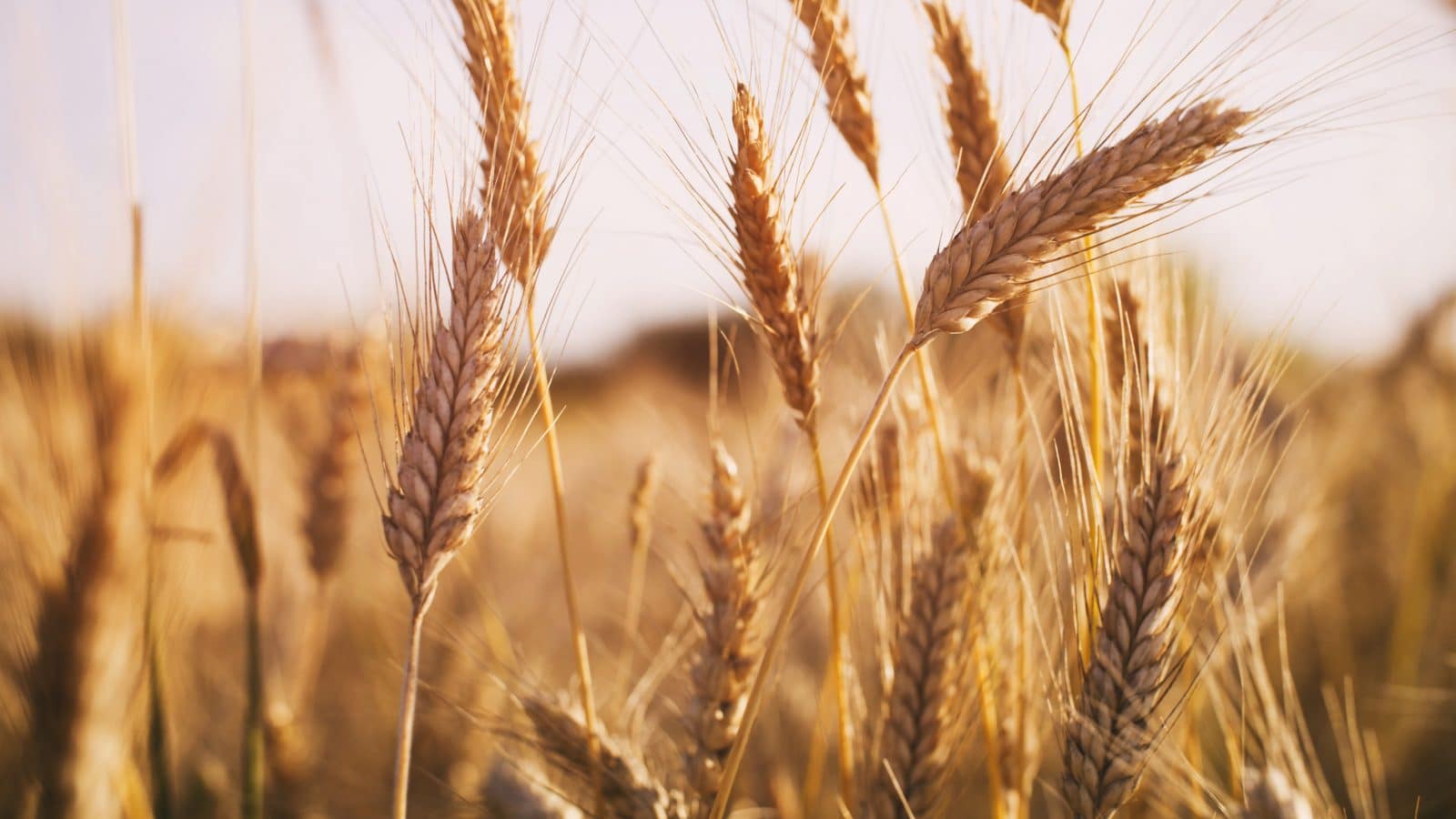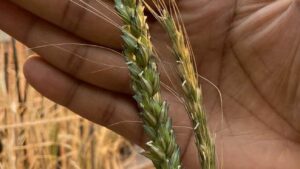Sequencing the wheat genome is like giving plant breeders and researchers Google Maps for crop improvement.
Researchers have been breeding new varieties of wheat using conventional cross-breeding approaches for a long time, but the process is expensive, time-consuming and unpredictable because it’s impossible to guarantee offspring will inherit just the right mix of genes from their parents. But this narrative is changing.
In August, after working 14 years on a project to crack bread wheat’s genome, researchers from 19 countries, published their findings in the journal Science. This is wheat’s first fully-annotated reference genome.
Using information provided by the completed reference genome sequence, breeders
now have tools to identify the genes and elements that regulate complex underlying agronomic traits such as yield, grain quality, resistance to fungal diseases and tolerance to abiotic stresses. Eventually this information will allow plant breeders to produce hardier wheat varieties to help feed the world’s growing population.

The impact of the wheat reference sequence has already been significant in the scientific community. On the same day the International Wheat Genome Sequencing Consortium (IWGSC) presented the genome sequence to the public, six additional publications described how the reference sequence resource was being used by scientists with advance access to the genomic information.
“A big part of sequencing is actually being able to put all of the sequence information back together,” explains Curtis Pozniak, a wheat breeder and professor at the University of Saskatchewan, as well as a member of the IWGSC. “Think about it like a puzzle.
“What we do is actually shatter the genome into these teeny tiny pieces and do the sequencing. Then we have to put that back together in the right order along all 21 chromosomes of the wheat genome.”
In many ways, Pozniak says that mapping the wheat genome is a bit like climbing a mountain and peering into the valley below. The opportunities are in the valley, but you have to climb the mountain first or the valley will remain hidden, he says.
Wheat geneticists with early access to the published information say the newly finished genome has transformed their research.
Early Impacts
The new genome has helped plant geneticists from the John Innes Centre in Norwich, England, boost grain size by 20 percent in lab-grown wheat. They report identifying
multiple copies of a gene for grain size originally found in rice. Using CRISPR, they bulked up wheat grains by mutating the genes.
Many more traits beckon. The new sequence “ushers in a new era in wheat genetics,” says James Anderson, a plant breeder at the University of Minnesota, St. Paul.
Researchers might also be able to more easily temper the dark side of wheat. Many people are allergic to glutens and other wheat proteins, leading to disorders including celiac disease, baker’s asthma, and non-celiac wheat sensitivity. Scientists have managed to identify many of the specific proteins responsible.
“Until now, we couldn’t determine the genes that encoded those proteins,” says Odd-Arne Olsen from the Norwegian University of Life Sciences. “With the availability of the high-quality IWGSC reference genome, we have used a comprehensive analysis workflow to precisely characterize the allergens and antigens in wheat proteins.”
Olsen’s team has now identified 356 such genes. Of these, 127 are new to science, and 222 were known but had been incorrectly sequenced. This information helps underpin research to modify or reduce the potential harmful effects of these proteins through selective breeding or improved targeted genetic modification.
Using the genome, breeders could also use plant breeding innovations, such as CRISPR, to rapidly alter specific characteristics. To show the ease at which this could be done, the IWGSC identified the wheat genes that influence flowering time and altered them with CRISPR to create varieties that bloom a few days earlier than usual. These techniques could also be used to move beneficial traits from wild wheat species into domestic strains.
The genome could also help bolster wheat’s resistance to disease. Drawing on the consortium data, Pozniak and Kirby Nilsen at the University of Saskatchewan in Saskatoon, found a gene that stiffens wheat stems, making them more resistant to sawflies. Stiffer wheat has more copies of the gene, Nilsen found, which points to ways to protect other wheat varieties.
“What took us years in the past now takes us one night,” says Jorge Dubcovsky of the University of California, Davis, who recently found a new gene for wheat height. “It’s like walking with a Google map.”
Despite the enormous opportunities, not all is rosy.
Public approval and regulatory restrictions will dictate just how far and how fast researchers are able to modify wheat as we know it.
In July, the Court of Justice of the European Union in Luxembourg, ruled that CRISPR-edited crops will be regulated as genetically-modified organisms, even if they don’t introduce genes from other organisms. Much to the dismay of the scientific community, CRISPR-derived crops now face a long and expensive approval process.
So even though the technological and scientific capacity exists to quickly modify wheat, many will opt not to and continue using traditional breeding methods.
The genomic information decoded by the IWGSC can benefit wheat breeders working to bring new non-GM traits with inherent value sought by consumers into various backgrounds to develop more widely-adapted varieties. One of the most recent developments using traditional breeding is that of high fiber wheat.
In June 2017, Bay State Milling Company launched HealthSense high fiber wheat flour milled from specific varieties of wheat that are conventionally bred without gene editing to increase the amount of amylose, a naturally occurring starch that resists digestion and meets the U.S. Food and Drug Administration definition of dietary fiber.
FDA defines dietary fiber as consisting of naturally-occurring fibers that are “intrinsic and intact” in plants, and other non-digestible soluble and insoluble carbohydrates that have beneficial physiological effects to human health.

Amylose Alteration
“HealthSense is a one-of-a-kind wheat flour with up to 10 times more dietary fiber than traditional wheat flour,” says Sean Finnie, Bay State Milling senior manager of research and development. “High fiber wheat has more amylose than amylopectin, which causes the starch to resist being broken down by digestive enzymes.
“It is a low-cost source of food fiber that is raised on a farm, not manufactured in a factory. Food fiber additives are five to 20 times more expensive than our HealthSense high fiber wheat. There is inherent value along the entire supply chain, from breeders to farmers, and from millers to bakers.”
A naturally-occurring starch, amylose resists digestion and acts as dietary fiber.
Bay State Milling’s HealthSense flour contains 25 percent dietary fiber, compared to
3 percent dietary fiber for traditional wheat flour.
There is no chemical difference in high fiber wheat; it’s simply a difference in the amylopectin ratio.
Amylose production is a one-step biochemical process, which adds one molecule of glucose at a time to form a protein chain. The amylopectin pathway is more complex with three steps. The first step is to build linear molecules of amylose. Step two stops the formation of branch points to the chain. The final step is to make the amylose molecule more compact. It is the second step that makes the starch more resistant to digestion, resulting in it being a dietary fiber.
Because the amylose is in the flour, there is no difference in dietary fiber between whole grain and milled flour.
“A simple change in the wheat’s biochemistry has a dramatic impact on the finished product,” Finnie says. “Plant breeders looked for varieties with mutations in the starch-branching step, the second step in amylopectin synthesis and found varieties with mutations in the starch branching enzymes which caused more resistant starch to be formed.”
Increased genomic data decoded by the IWGSC may provide additional information to help breeders develop new high fiber varieties adapted
to local environments and farming practices. 
Bay State Milling and Arista Cereal Technologies have partnered for several years to develop varieties to satisfy both farmers and food companies to build a reliable, resilient and scalable supply chain. Arista is a joint-venture company between Limagrain and CSIRO, Australia’s National Research Agency. The companies began collaborating on fundamental research in wheat starch 20 years ago and joined their efforts and expertise in 2006 to develop and commercialize wheat with direct consumer health benefits.
Behind the Discovery
“The publication of the wheat reference genome is the culmination of the work of many individuals who came together under the banner of the IWGSC to do what was considered impossible,” explains Kellye Eversole, IWGSC executive director. “The method of producing the reference sequence and the principles and policies of the consortium provide a model for sequencing large, complex plant genomes and reaffirms the importance of international collaborations for advancing food security.”
All data related to the reference genome of bread wheat were released to the scientific community as soon as they became available in January 2017. They have been publicly available without restriction since July 2018.
Common bread wheat, Triticum aestivum, has one of the most complex genomes known. There are six copies of each of its 21 chromosomes with an enormous number of near-identical sequences scattered throughout.
The first effort to sequence the genome, published in 2012, used an earlier generation of sequencing technology and assembled only 5.42 billion bases, approximately one-third of the genome. In comparison, the newly finished genome includes 15 billion bases and covers 94 percent of the total genome. The new information identifies 107,891 high confidence genes including their genomic context of regulatory sequences on bread wheat’s 21 chromosomes.
Typically, geneticists sequence genomes by breaking DNA into small segments, reading them separately and assembling the pieces back together. But if each chromosome occurs six times, how do they know where to put any given piece? Worse still, 85 percent of wheat’s DNA consists of repetitive sequences, so even if geneticists narrow a piece down to the right chromosome, it’s still a chore to work out where exactly it should sit.
It’s like solving a giant jigsaw puzzle that depicts the same patch of blue sky three times over.
“You have no idea where things go,” says Eversole. “It’s really a miracle that we finished. The genome sequence of maize had a big impact on creating better varieties. The goal now is to build a better wheat breeder’s toolbox and increase profitability for growers.”
The sequenced genome comes from Chinese Spring, an unusual variety which few farmers would recognize as wheat. It is historically important as the foundation of early wheat research. Now that its genome data has been published, it will be much easier for scientists to sequence a wider range of cultivars and understand the genetic underpinnings of different traits.
“This annotated reference sequence of wheat is a resource that can now drive disruptive innovation in wheat improvement, as this community resource establishes the foundation for accelerating wheat research and application through improved understanding of wheat biology and genomics-assisted breeding,”
says Rudi Appels, an AgriBio Research Fellow and professor at the University of Melbourne and Murdoch University. “Importantly, the bioinformatics capacity developed for model-organism genomes will facilitate a better understanding of the wheat genome as a result of the high-quality chromosome-based genome assembly.
“By necessity, breeders work with the genome at the whole chromosome level, as each new cross involves the modification of genome-wide gene networks that control the expression of complex traits such as yield.”
Appels says that with the annotated and ordered reference genome sequence, researchers can now access sequence-level information to precisely define the necessary changes in the genomes for breeding. This will be realized through the implementation of new DNA marker platforms and targeted breeding technologies.












